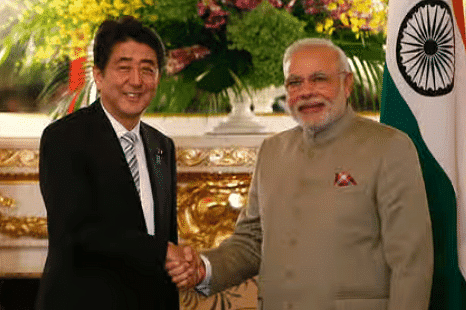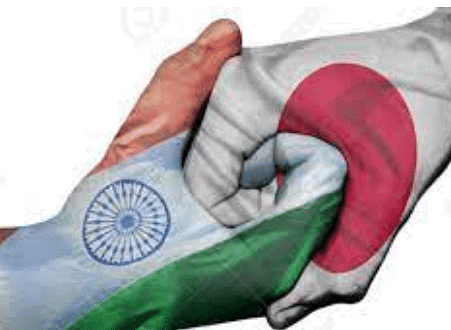CDS Exam > CDS Notes > Preparation Tips for SSB Interview > Sample Lecturette 8: India-Japan Relations
Sample Lecturette 8: India-Japan Relations | Preparation Tips for SSB Interview - CDS PDF Download
| Table of contents |

|
| Know about India-Japan Relations |

|
| Historical ties |

|
| Economic Relations |

|
| Defence |

|
Know about India-Japan Relations
India and Japan have developed a strong relationship in recent years, spanning politics, economics, and culture. Shinzo Abe, Japan's longest-serving Prime Minister, referred to Japan as a lifelong friend of India. The modern connection between the two countries is crucial for fostering peace, stability, and development in Asia.

Historical ties
Historically, the roots of the India-Japan relationship can be traced back to the 6th century CE when Buddhism was introduced to Japan. The Japanese Emperor, Shomu, built the Todaji temple in Nara and invited the Indian Buddhist Scholar, Bodhisena, to oversee its opening ceremony in 752 CE. Even today, various Hindu deities from India are worshipped in Japan.
During the medieval period, Japan isolated itself from the outside world, and it was only after the Meiji restoration in 1868 that bilateral relations between India and Japan gained momentum. Swami Vivekananda visited Japan in 1893 while en route to the Parliament of World Religions in Chicago.
In 1903, the Japan-India Association was established with support from the Japanese government, which also backed the Indian Independence movement. Indian revolutionaries received support from the Imperial Japanese Army, and in 1915, Rash Bihari Bose escaped to Japan and formed the Indian Independence League. Japan also aided the Indian National Army (INA) by providing manpower and resources.
During the Tokyo Trials in 1949, following World War II, Indian Justice Radhabinod Pal was the sole judge who argued in favor of Japan. India established diplomatic relations with Japan soon after Japan's independence in 1952, making it one of the first countries to do so. In 1957, Nobusuke Kishi became the first Japanese Prime Minister to visit India, while Jawaharlal Nehru became the first Indian Prime Minister to visit Japan.
Japan provided unconditional support during India's balance of payment crisis in 1991. In the early 21st century, Indo-Japan relations experienced rapid growth, highlighted by the signing of the Comprehensive Economic Partnership Agreement (CEPA) in 2011.
Economic Relations

- Japanese investment in India during the fiscal year 2018-19 amounted to US$2.96 billion. As of August 2020, there were 1,454 registered Japanese companies in India, representing a growth of 13 companies (0.9%) compared to October 2018.
- India exports various items to Japan, including petroleum products, non-metallic mineral ware, fish, textiles, iron and steel products, chemicals, textile yarn, and metalliferous ores and scrap.
- On the other hand, India primarily imports machinery, electrical machinery, iron and steel products, plastic materials, non-ferrous metals, motor vehicles, and accessories from Japan.
- Japan has been a significant bilateral donor to India since 1958, providing loan and grant assistance under the Official Development Assistance (ODA) program. In the year 2018-19, Japan committed Japanese Yen 416.458 billion for ODA programs in India. These funds support India's economic development in sectors such as power, transportation, environmental projects, and projects related to basic human needs.
- India and Japan have also launched the Asia Africa Growth Corridor (AAGC) to strengthen economic ties between Asia and Africa.
Here are some ongoing economic projects between India and Japan:
- The Delhi Mumbai Industrial Corridor (DMIC)
- Chennai Bengaluru Industrial Corridor
- Development of 12 potential sites as Japan Industrial Townships (JITs) in India, located in Rajasthan, Maharashtra, Gujarat, Madhya Pradesh, Haryana, Andhra Pradesh, Tamil Nadu, Karnataka, and Uttar Pradesh.
- The Western Dedicated Freight Corridor Project, spanning 1504 km from Dadri to JNPT, is being executed with funding of JPY 550 billion from JICA.
- The Mumbai-Ahmedabad High-Speed Railway (MAHSR)
- The India-Japan Digital Partnership (IJDP) initiative
Defence
- The relationship between India and Japan is very important for peace and stability in the Indo-Pacific region. China's expansionist policies have caused problems for both countries. The military partnership between India and Japan is a crucial part of their bilateral relations.
- India and Japan engage in various military exercises together and actively participate in multilateral military exercises. One of these exercises is the Malabar Exercise, which involves the navies of India, Japan, and the USA. In 2019, India and Japan also conducted the mine-countermeasures exercise (MINEX) together.
- To strengthen their cooperation, India and Japan signed the "Acquisition and Cross-Servicing Agreement" (ACSA) in order to provide reciprocal supplies and services between the Self-Defense Forces of Japan and the Indian Armed Forces. They also conduct two other military exercises called Shinyuu Maitri and Dharma Guardian.
- In January, the 19th Indian Coast Guard-Japanese Coast Guard Joint-Exercise was held in Chennai. Furthermore, the first India-Japan Space Dialogue took place in New Delhi on 7th March 2019, and the first Japan-India 2+2 Foreign and Defence Ministerial Meeting was held in Delhi on 30th November 2019.
- In 2014, India and Japan signed a Memorandum of Cooperation and Exchanges in the Field of Defence, aiming to facilitate the transfer of defence technology.
The 21st century has been projected as the century dominated by Asia, and India and Japan will play crucial roles in the years to come. In a world threatened by an ambitious China, the Indo-Japan relationship will be key to maintaining stability in the region. India is also forming a quadrilateral alliance with the USA, Japan, and Australia to counter the threat from China. The growing economic cooperation between India and Japan will not only be mutually beneficial but will also provide a united front against their common adversaries.
The document Sample Lecturette 8: India-Japan Relations | Preparation Tips for SSB Interview - CDS is a part of the CDS Course Preparation Tips for SSB Interview.
All you need of CDS at this link: CDS
|
113 videos|112 docs|65 tests
|
Related Searches



















